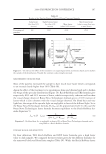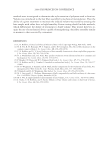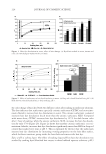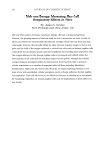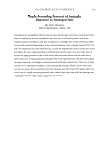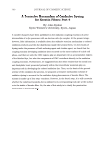2008 TRI/PRINCETON CONFERENCE 167 MEASUREMENT ON BLOND HAIR Most of the panelist estimated the sample to have much more luster which corresponds to an increase clearly higher than 50% (Table III). Again the effect of the treatment is to superimpose shine and chroma band and to darken the wings of the specular distribution (Figure 16). Reich-Robbins and TRI formulae give respectively 80% and 44% increase of luster, which is respectively coherent and less than the visual change observed. Bossa Nova Technologies formula gives a 110% increase of luster which is also coherent with the visual change observed. On blond hair and very light hair, the wings of the specular light are negligible in front of the diffused light. So in the Bossa Nova Technologies formula, D+Sout can be approximated to D. In this case the Bossa Nova Technologies luster formula becomes equivalent to the Reich-Robbins for- mula (Equation 5). Sout D LBNT S D S S D Wvisual in out in + = ( )*Wvisual ~ * (5) Equation 5. On blond hair, Sout is negligible in front of D, so Bossa Nova Technologies formula can be simplifi ed to a Reich-Robbins formula. DYNAMIC RANGE AND SENSITIVITY By their defi nition, TRI, Reich Robbins and BNT luster formulae give a high luster value to dark samples. We compared the luster values given by the different formulae for the untreated black and blond hair samples (Table IV). While the Reich Robbins luster Table II Results of the Panelist Rating of Treated Versus Untreated Samples Same luster (less than 10% increase) Slightly more luster (less than 30% increase) More luster (about 50% increase) Much more luster (about or more than twice as much luster) Percentage of panelists 0% 12% 63% 25% Figure 15. On red hair the effect of the treatment is to superimpose shine and chroma bands and to darken the outside of the distribution. Visually the contrast is also strongly increased.
JOURNAL OF COSMETIC SCIENCE 168 is as much as 5 times higher for black hair compared to blond hair, TRI and BNT luster is only twice as much for black hair compared to blond hair. BNT Luster has an increased sensitivity to treatments on hair with no artifi cial luster range dilatation. The Luster sensitivity is increased while keeping the variations of luster for the different hair tress in the same order of TRI formula. CONCLUSIONS We have experimentally validated the polarization imaging technique to quantify the visual appearance of hair. Polarization enables an accurate and physical decomposition of the true diffused light. This decomposition is a powerful tool to improve hair visual ap- pearance characterization and to better understand the effect of treatments. This tech- nique delivers data and images related to the human visual assessment. Based on luster formulae developed mainly for photogoniometer, we introduced a new luster formula Figure 16. On blond hair the effect of the treatment is the same as on red hair. Visually the contrast is also strongly increased. Table IV The Luster Range of BNT Luster Is Similar to the TRI Formula While Having More Sensitivity Luster formula Reich-Robbins TRI BNT Black 169.2 25.0 27.6 Blond 31.1 11.8 12.8 Ratio 5.4 2.1 2.2 Table III Results of the Panelist Rating of Treated Versus Untreated Samples Same luster (less than 10% increase) Slightly more luster (less than 30% increase) More luster (about 50% increase) Much more luster (about or more than twice as much luster) Percentage of panelists 12% 0% 38% 50%
Purchased for the exclusive use of nofirst nolast (unknown) From: SCC Media Library & Resource Center (library.scconline.org)














































































